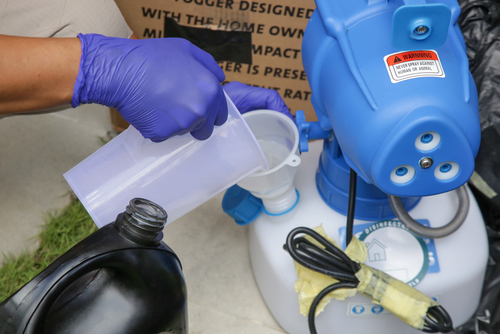
Can Disinfection Service Eliminate Coronavirus?
June 14, 2020
10 Office Frequently Touched Areas To Disinfect
July 13, 2020Can Disinfection Robot Fight Coronavirus?

Want to know can disinfection robot fight coronavirus? Still, to date, there is a huge lag behind huge scale testing for coronavirus and research indicates that the vaccine can take up to a year to develop. However, in this tough battle against a huge worldwide pandemic soaring rapidly, there is also a quickly expanding robot brigade ready to answer their vital call of duties: disinfection of surface.
Their numbers can be seen in steady incline not only in nursing homes and hospitals but also across a broad spectrum of different types of spaces such as offices, residential buildings, airports, universities, and hotels as well.
Administrators of different stripes are quite desperate for the safety of people and are looking for ly emerging robotics industry which has shown a quick response with the new disinfection robot technology.
Can Disinfection Robot Fight Coronavirus? –
What do Robot Suppliers Think?

Demark based UVD Robots, is the current leader of autonomous UV-light robots for disinfection and has shipped huge numbers of these in China in the month of February and a hundred more of these throughout Europe in the month of March. Per Juul Nielsen, CEO, UVD Robots, stated that “A small number arrived in the U.S. but various hundreds with more and more remain on their way.”
Nielsen stated that Hospitals worldwide are presently going for autonomous disinfection and due to the rapid surge in demand, it’s not possible for us to bring disinfection robot models to production quickly.
Another leading ultravoilet-light zapping robots manufacturer, Xenex, San Antonio, TX, has shipped their LightStike bots in hundreds of numbers worldwide. They have also been shipped to around 70 Veterans Administration healthcare facilities in the United States and also for ten sites that are run through U.S. Defense department, Morris Miller, CEO, Xenex, stated to CNBC this week.
How Well are the Robots Performing?

Leading suppliers of Healthcare sectors such as Xenex, UVD and various other still have to go quite long enough to meet the exploding global demands of the solutions of automated disinfection but these are not only special service robots that ride in battle.
The Human-friendly industry facility robots are also called as the collaborative robots have been shifted away from various tasks, like warehouse stacking and machine tending. They were redeployed for continuing with the way of COVID-19.
“In mobile (robot) age, large amounts of inbound related (inquiries) surround the (chemical and UV-light) disinfection,” according to Melonee Wise, CEO, Fetch Robotics, San Jose, California.
In comments in a webcast recently held by Association for Advancing Automation (A3), told that the staff is currently fielding more than 20 leads in one day, from company representatives and institutions as well, all want to know that: “is it possible to have disinfection for my facility?”
How Reliable are the Robots?

This month, earlier, a special research team at USC Viterbi Center for Advanced Manufacturing. Intensely working (with social distancing) since a few weeks, retooled semi-autonomous type mobile manipulator, which was robot commonly required in smaller factories along with warehouses.
The modified outcome here was that the “ADAMMS_UV” robot comprised mainly of three different components of hardware. For mobile base, whole team made use of Inspectorbots’ SuperMega Bot” mounted on base is UR5 arm through the Universal Robots; on arm, a two-fingered Robotiq gripper.
Later on, they fitted it with the ultraviolet-light wands with augmented vision guidance with new software for learning about dangerous disinfection works in places like offices and dorm rooms, and spaces that are difficult to thoroughly clean through autonomous disinfection robots without arms.
USC’s robot has been fitted with a human operator remotely working, while making serious decisions, like “open the door”, “pause”.
“Being a society we’ve got tremendous work ahead for disinfection of public spaces,” as told by Sayandra Gupta, director, USC Center for Advanced manufacturing and Smith International Professor of Mechanical Engineering and Computer Science.
The group headed by Gupta was responsible to assure the working of robot. It meant that we’ll have to apply different mobile robots – quite a lot,” said by Gupta.
Are these Robots the next thing in Demand?

In the past recent weeks, the Xenex corporation witnessed a notable surge in their sales coming through their general customers, like urgent care centers and hospitals, along with companies, office buildings, hotels and government agencies.
As the company is having a wide worldwide network consisting of distributors and suppliers, it sensed the emergence of pandemic early in that month of December.
In January when the virus was around China, the company Xenex started maximizing its production. In February within a short time period of a few days, they shipped a lot of robots in Italy.
All told, the LightStrike robots by Xenex are now deployed in up to 500 healthcare centers throughout the world.
Similarly, a surge has been there in interest the competitor UVD Robots, while capping four-year global mission for building, testing and coming for marketing with autonomous mobile robots that enter room and also safety disinfecting UV-light.
The UVD has been owned through privately Blue Ocean Robotics, which is known for the Robot Venture Facility in Odense, Southern Denmark.
Can Disinfection Robot Fight Coronavirus? – Conclusion
In general, the service robot market has exponentially been on an increase since the surge of coronavirus. Around 271,000 of all such robots were in the global sales previous year as per data by the International Federation of Robotics. This was a surge of more than 61% compared to 2018.




